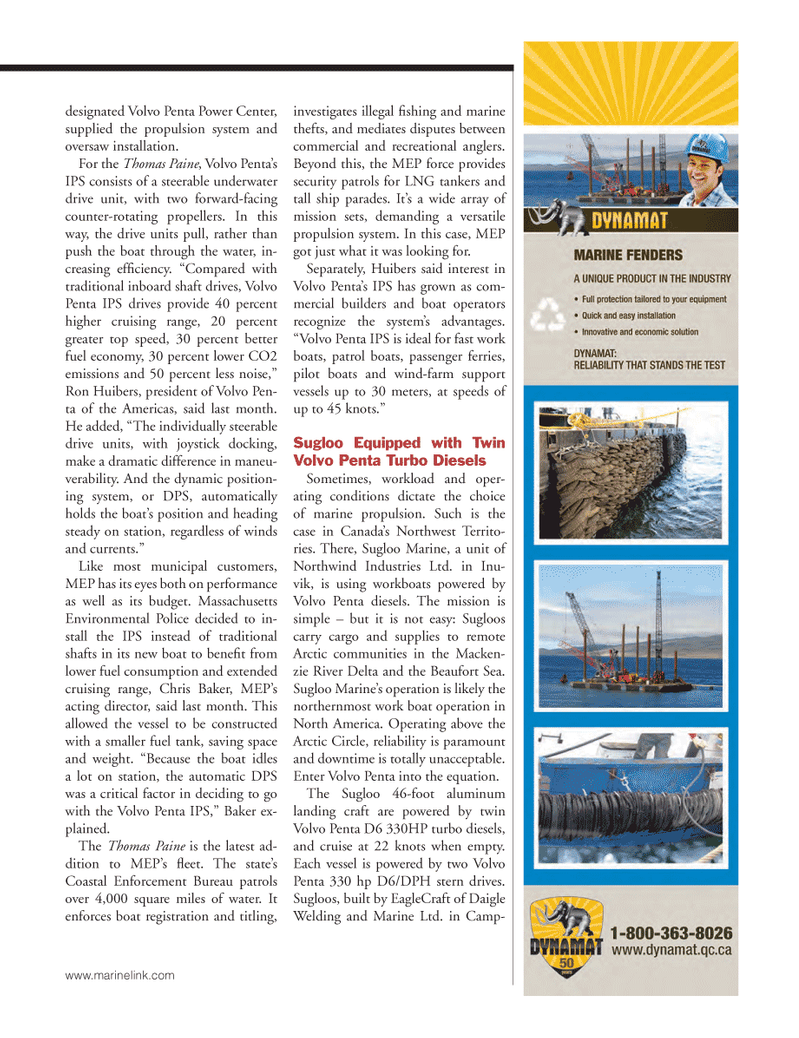
Page 35: of Marine News Magazine (September 2014)
Inland Waterways
Read this page in Pdf, Flash or Html5 edition of September 2014 Marine News Magazine
designated Volvo Penta Power Center, supplied the propulsion system and oversaw installation. For the Thomas Paine , Volvo Penta?s IPS consists of a steerable underwater drive unit, with two forward-facing counter-rotating propellers. In this way, the drive units pull, rather than push the boat through the water, in- creasing ef ciency. ?Compared with traditional inboard shaft drives, Volvo Penta IPS drives provide 40 percent higher cruising range, 20 percent greater top speed, 30 percent better fuel economy, 30 percent lower CO2 emissions and 50 percent less noise,? Ron Huibers, president of Volvo Pen- ta of the Americas, said last month. He added, ?The individually steerable drive units, with joystick docking, make a dramatic difference in maneu- verability. And the dynamic position- ing system, or DPS, automatically holds the boat?s position and heading steady on station, regardless of winds and currents.? Like most municipal customers, MEP has its eyes both on performance as well as its budget. Massachusetts Environmental Police decided to in- stall the IPS instead of traditional shafts in its new boat to bene t from lower fuel consumption and extended cruising range, Chris Baker, MEP?s acting director, said last month. This allowed the vessel to be constructed with a smaller fuel tank, saving space and weight. ?Because the boat idles a lot on station, the automatic DPS was a critical factor in deciding to go with the Volvo Penta IPS,? Baker ex- plained.The Thomas Paine is the latest ad-dition to MEP?s eet. The state?s Coastal Enforcement Bureau patrols over 4,000 square miles of water. It enforces boat registration and titling, investigates illegal shing and marine thefts, and mediates disputes between commercial and recreational anglers. Beyond this, the MEP force provides security patrols for LNG tankers and tall ship parades. It?s a wide array of mission sets, demanding a versatile propulsion system. In this case, MEP got just what it was looking for. Separately, Huibers said interest in Volvo Penta?s IPS has grown as com- mercial builders and boat operators recognize the system?s advantages. ?Volvo Penta IPS is ideal for fast work boats, patrol boats, passenger ferries, pilot boats and wind-farm support vessels up to 30 meters, at speeds of up to 45 knots.?Sugloo Equipped with Twin Volvo Penta Turbo Diesels Sometimes, workload and oper- ating conditions dictate the choice of marine propulsion. Such is the case in Canada?s Northwest Territo- ries. There, Sugloo Marine, a unit of Northwind Industries Ltd. in Inu- vik, is using workboats powered by Volvo Penta diesels. The mission is simple ? but it is not easy: Sugloos carry cargo and supplies to remote Arctic communities in the Macken- zie River Delta and the Beaufort Sea. Sugloo Marine?s operation is likely the northernmost work boat operation in North America. Operating above the Arctic Circle, reliability is paramount and downtime is totally unacceptable. Enter Volvo Penta into the equation. The Sugloo 46-foot aluminum landing craft are powered by twin Volvo Penta D6 330HP turbo diesels, and cruise at 22 knots when empty. Each vessel is powered by two Volvo Penta 330 hp D6/DPH stern drives. Sugloos, built by EagleCraft of Daigle Welding and Marine Ltd. in Camp- www.marinelink.com MN Sept14 Layout 32-49.indd 35MN Sept14 Layout 32-49.indd 358/20/2014 11:35:48 AM8/20/2014 11:35:48 AM

 34
34

 36
36
